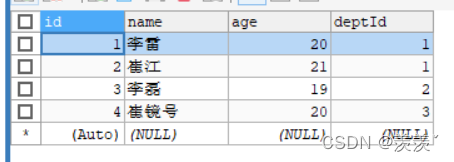MyBatis深入解读动态SQL的实现
目录
- if和where
- trim
- Choose
- Set
- foreach
mybatis最强大的功能之一便是它的动态sql能力
借用官方文档的一段话 : 如果您以前有使用JDBC或者类似框架的 经历,您就会明白把SQL语句条件连接在一起是多么的痛苦,要确保不能忘记空格或者不要在 columns列后面省略一个逗号等。动态语句能够完全解决掉这些痛苦。
那么如果没有这种功能到底有多痛苦呢 ? 我们来举例说明

这是一张表 , 试想如果我们通过 name 和 age来查询表信息时 , sql语句中肯定会存在 where和and字句 , 但是如果 name或者age 有一个为null或者都为null , 那么此时的 where 和and就会被孤立,那么这样肯定会出现很多问题 , 所以mybatis的动态sql功能帮助我们完美解决
MyBatis 中用于实现动态 SQL 的元素主要有:
If where trim set choose(when, otherwise) foreach
if和where
<select id="selectAllEmployee1" resultMap="employeeMap2" parameterType="Employee">
SELECT e.id,e.name ename,e.age,d.name dname FROM employee e
LEFT JOIN dept d ON e.deptId = d.id
<where>
<if test="name!=null & name!=''">
e.name =#{name}
</if>
<if test="age!=null & age!=''">
and e.age =#{age}
</if>
</where>
</select>
使用这种标签 , 动态sql可以根据 条件来自动帮我们完善sql
SqlSession sqlSession= MybatisUtil.getSqlSession();
EmployeeDao mapper=sqlSession.getMapper(EmployeeDao.class);
//创建一个对象,set值
Employee employee = new Employee();
employee.setName("");
employee.setAge(null);
List<Employee> employees = mapper.selectAllEmployee1(employee);
System.out.println(employees);
sqlSession.commit();
sqlSession.close();
第一次我们都设置null值, 表中数据完全被查询

第二次我们只查询年龄
employee.setName("");
employee.setAge(20);

查询到两条年龄为20的数据 , 这就是mybatis动态sql的强大之处
trim
上述的 where 与 if 我们也可以使用 trim 来代替where
<select id="selectAllEmployee1" resultMap="employeeMap2" parameterType="Employee">
SELECT e.id,e.name ename,e.age,d.name dname FROM employee e
LEFT JOIN dept d ON e.deptId = d.id
<trim prefix="where" prefixOverrides="or|and">
<if test="name!=null & name!=''">
e.name =#{name}
</if>
<if test="age!=null & age!=''">
and e.age =#{age}
</if>
</trim>
</select>
这里有两个属性 prefix , prefixOverrides
prefix : 代表前缀 , 如果if 中有成立的条件, 就会在sql前面拼入where字句
prefixOverrides : 根据if 条件自动判断是否去除 or | and字句
相应的也有suffix与suffixOverrides , 代表对尾部的判断
Choose
choose代表多路选择(多选一)
<select id="selectAllEmployee1" resultMap="employeeMap2" parameterType="Employee">
SELECT e.id,e.name ename,e.age,d.name dname FROM employee e
LEFT JOIN dept d ON e.deptId = d.id
<trim prefix="where" prefixOverrides="or|and">
<choose>
<when test="name!=null & name!=''">
and e.name =#{name}
</when>
<when test="age!=null">
and e.age =#{age}
</when>
<otherwise>
and e.name ='李雷'
</otherwise>
</choose>
</trim>
</select>
当<when>中的条件成立时, 走when中的语句,都不成立走<otherwise>
Set
set 可以根据条件自动添加set字句,动态更新列,也可以来剔除追加到条件末尾的任何不相关的逗号
<update id="updateEmployee">
update employee
<set>
<if test="name!=null & name!=''">
name=#{name},
</if>
<if test="age!=null">
age=#{age},
</if>
</set>
where id=#{id}
</update>
foreach
<foreach> 主要用在构建 in 条件中,它可以在 SQL 语句中进行迭代一个集合。foreach元素的属性主要有 item,index,collection,open,separator,close。 item 表示集合中每一个元素进行迭代时的别名,index 指定一个名字,用于表示在迭代过程中,每次迭代到的位置,open 表示该语句以什么开始, separator 表示在每次进行迭代之间以什么符号作为分隔符,close 表示以什么结束,在使用 foreach 的时候最关键的也是最容易出错的就是 collection 属性,该属性是必须指定的,但是在不同情况下,该属性的值是不一样的。
– 如果传入的是单参数且参数类型是一个 List 的时候,collection 属 性值为 list
– 如果传入的是单参数且参数类型是一个 array 数组的时候, collection 的属性值为array
//创建一个list集合 List<Integer> list = new ArrayList<>(); list.add(19); list.add(20); List<Employee> employees = mapper.selectAllEmployee2(list);
接口方法如下 :
List<Employee> selectAllEmployee2(List<Integer> list);
对应动态sql如下 :
<select id="selectAllEmployee2" resultMap="employeeMap2" parameterType="Employee">
SELECT e.id,e.name ename,e.age,d.name dname FROM employee e
LEFT JOIN dept d ON e.deptId = d.id where age in
<foreach collection="list" item="age" open="(" separator="," close=")">
#{age}
</foreach>
</select>
这里我们传入的是一个集合, 所以参数选择 list , 通过foreach我们可以动态的根据集合里的值来查询
关于动态sql就介绍到这,感谢阅读 !
到此这篇关于MyBatis深入解读动态SQL的实现的文章就介绍到这了,更多相关MyBatis动态SQL内容请搜索我们以前的文章或继续浏览下面的相关文章希望大家以后多多支持我们!

